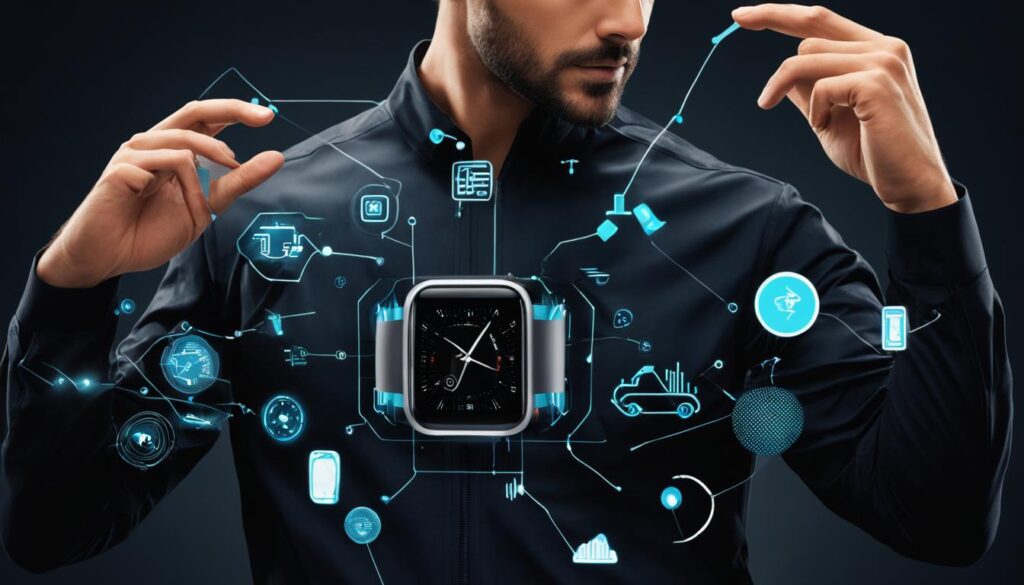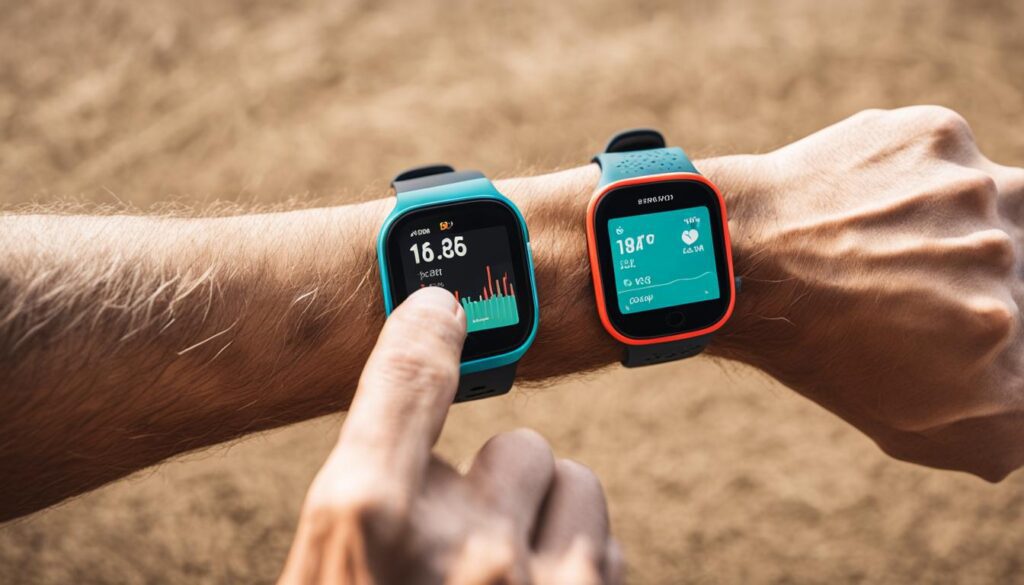Wearable technology has become a prominent part of our lives, offering us a whole new level of convenience and functionality. From smartwatches to fitness trackers, these electronic devices are designed to be worn on the body and have the ability to connect to the internet, giving us access to real-time data and enhancing our daily experiences. In this article, we will delve into the world of wearable tech and explore its various aspects, including its definition, evolution, and key applications. So, let’s dive in and discover the fascinating world of wearable technology!
Key Takeaways:
- Wearable technology refers to electronic devices designed to be worn on the body.
- These devices offer various functions such as health monitoring and real-time data processing.
- Wearable tech has evolved over time, encompassing smartwatches, fitness trackers, and even smart clothing.
- The core functions of wearable tech include connectivity, real-time data, and user interactions.
- Wearable technology has diverse applications in healthcare, entertainment, and sports industries.
What Is Wearable Technology?
Wearable technology has evolved over time, from simple devices like eyeglasses and watches to more advanced forms like smart clothing. It is defined as any electronic device that can be worn on the body and typically includes microprocessors and internet connectivity.
The Evolution and Definition of Wearable Tech
From its humble beginnings, wearable technology has undergone significant advancements. Early wearables like the first eyeglasses and calculator watches laid the foundation for the technology we have today. The definition of wearable tech encompasses devices that can be worn on the body and perform various functions, such as collecting health data, providing notifications, and enabling user interactions.
From Watches to Smart Clothing: The Spectrum of Wearables
The spectrum of wearables is vast, ranging from fitness trackers and smartwatches to smart clothing and accessories. Smartwatches, for example, offer features like fitness tracking, notifications, and even mobile payments. On the other end of the spectrum, smart clothing and accessories combine fashion with functionality, integrating technology seamlessly into garments and accessories.
Wearable Tech’s Core Functions: Connectivity, Real-Time Data, and User Interactions
The core functions of wearable technology revolve around connectivity, real-time data, and user interactions. Wearable devices enable users to stay connected by syncing with smartphones or other devices. Real-time data collection, such as monitoring heart rate or steps taken, allows users to track their health and fitness goals. User interactions are made possible through interfaces like touchscreens, buttons, or voice commands, providing convenient and hands-free control over wearable gadgets.
How Wearable Technology Operates
Wearable technology, such as smartwatches and fitness trackers, operates through the use of specialized components and functionalities. These wearable devices rely on processors, sensors, and internet connectivity to deliver their unique features and capabilities.
The Tech Behind the Trend: Processors, Sensors, and Internet Connectivity
At the core of wearable technology are microprocessors, which are small computer chips that enable data processing and perform various functions. These processors allow wearables to run complex algorithms, process user commands, and communicate with other devices.
Sensors play a crucial role in wearables by collecting data from the user’s body or surrounding environment. These sensors can detect various parameters, such as movement, heart rate, temperature, and ambient light. By continuously monitoring these inputs, wearables can provide real-time information and personalized insights.
Internet connectivity is another key component of wearable technology. Through wireless connections, wearables can sync data with other devices, such as smartphones or computers. This connectivity enables users to access their data remotely, receive notifications, and even interact with external services or applications.
Tracking Health and Fitness: Insight into Biometric Monitoring
One of the primary applications of wearable technology is in the field of health and fitness. Wearables equipped with biometric sensors can monitor vital signs, track physical activity, and provide valuable health-related insights.
For example, fitness trackers can measure metrics like steps taken, distance traveled, and calories burned. They can also monitor heart rate, sleep patterns, and even oxygen levels. This data can help individuals set goals, track progress, and make informed decisions about their overall well-being.
Health-focused wearables, such as smartwatches with built-in heart rate monitors and blood pressure sensors, provide continuous monitoring of vital signs. This allows users to detect irregularities, track trends, and manage their health more effectively.
Interacting with Wearable Gadgets: User Interfaces and Controls
Wearable devices are designed to provide seamless and convenient user interactions. They offer various user interfaces and control mechanisms, allowing users to easily navigate through features and functionalities.
Touchscreens are a popular interface option for many wearables, such as smartwatches. Users can interact with the device by tapping, swiping, or scrolling on the screen. This enables easy access to applications, settings, and notifications.
Buttons and physical controls are also commonly found in wearables. They allow users to perform specific actions, such as adjusting volume, activating features, or navigating menus. These physical controls provide tactile feedback and can be especially useful during workouts or other activities where touchscreen interactions may be challenging.
In addition, voice commands and voice recognition are becoming increasingly integrated into wearable devices. With built-in microphones and advanced speech recognition technology, wearables can understand and respond to users’ voice commands, allowing for hands-free operation.

Key Applications and Impact of Wearable Tech
Wearable technology has revolutionized various industries with its diverse applications and significant impact. From healthcare to entertainment and sports, wearable tech has paved the way for immense advancements and improvements.
Breaking Bounds in Healthcare with Remote Monitoring and Diagnosis
In the field of healthcare, wearables have become game-changers by enabling remote monitoring and diagnosis. These devices allow healthcare professionals to seamlessly track patients’ health conditions and provide timely interventions, even from a distance. With wearable tech, patients can receive personalized care and continuous monitoring, leading to better healthcare outcomes and improved patient experiences.
Game Changers: Wearables Transforming the Entertainment Industry
The entertainment industry has also witnessed a significant transformation due to the integration of wearables. Devices such as virtual reality headsets and smart glasses have revolutionized gaming and media consumption, offering users immersive experiences like never before. Whether exploring virtual worlds or enhancing live events, wearables have brought entertainment to a new level, captivating audiences and creating interactive and engaging experiences.
Enhancing Performance: The Role of Wearables in Sports and Fitness
Wearable technology has had a profound impact on the sports and fitness industry, empowering athletes and fitness enthusiasts to optimize their performance. Fitness trackers and smart clothing have enabled individuals to monitor their progress, track vital signs, and analyze data to improve their training routines. By providing real-time feedback and personalized insights, wearables have revolutionized the way people approach fitness and sports, helping them reach their goals and maximizing their potential.

Overall, wearable technology has proven to be a versatile tool with applications extending across different sectors. Its impact can be seen in remote healthcare monitoring, immersive entertainment experiences, and enhanced sports and fitness performance. With continuous advancements and innovations, the potential for wearables in these industries and beyond is limitless, shaping the future of technology and improving our daily lives.
Exploring Various Examples of Wearable Technology
Wearable technology offers a wide range of options for users, from smartwatches and fitness trackers to smart clothing and medical wearables. Let’s take a closer look at some popular examples in each category.
Essential Wearable Devices: Smartwatches and Fitness Trackers
![]()
Smartwatches have become a staple in the wearable tech industry. These devices not only tell time but also provide a host of features like notifications, fitness tracking, and even mobile payment capabilities. With sleek designs and customizable watch faces, smartwatches have become a fashion statement while keeping users connected.
Fitness trackers, on the other hand, are designed specifically for monitoring physical activity, sleep patterns, and overall health and wellness. These devices help users set fitness goals, track their progress, and stay motivated to maintain an active lifestyle. With features such as heart rate monitoring and step counting, fitness trackers are ideal companions for fitness enthusiasts.
Fashion Meets Functionality: Smart Clothing and Accessories
Smart clothing and accessories combine fashion with functionality, allowing users to seamlessly integrate technology into their everyday attire. These innovative garments and accessories incorporate sensors and connectivity, enabling users to interact with their devices effortlessly.
Smart clothing includes items like jackets, shoes, and even socks that can monitor body temperature, track movement, and provide posture correction. These pieces of clothing offer a perfect blend of fashion and technology, enhancing comfort and performance.
Accessories such as smart glasses, earrings, and bracelets bring wearable technology to new heights. These devices often feature augmented reality capabilities, allowing users to experience immersive visual content and interact with the digital world.
High-Tech Health Aids: The Advancement in Medical Wearables
Medical wearables have seen significant advancements in recent years, revolutionizing the healthcare industry. These devices have the potential to monitor vital signs, track medication adherence, and even detect early signs of health conditions. Medical wearables offer a non-invasive and convenient way to gather valuable health data.
For example, wearable heart rate monitors enable individuals to track their heart health and detect irregularities. Sleep trackers help users monitor sleep quality and identify potential sleep disorders. Continuous glucose monitors allow diabetic patients to track their blood sugar levels in real-time without the need for constant finger pricking.
Medical wearables are transforming the way patients and healthcare professionals manage and monitor health, empowering individuals to take control of their well-being.
As wearable technology continues to evolve, the possibilities are endless. From smartwatches and fitness trackers to smart clothing and medical wearables, these examples showcase the diverse range of wearable tech available and its potential to enhance our daily lives.
The Revolutionary Timeline of Wearable Tech
Wearable technology has a rich history that spans centuries, with innovations and milestones that have shaped the industry and transformed the way we interact with technology. From its humble beginnings to the modern wearables we have today, let’s explore the origin stories and the significant milestones in wearable innovation.
Origin Stories: From the First Eyeglasses to Calculator Watches
The history of wearable technology dates back to the 13th century with the invention of eyeglasses, which revolutionized vision correction. Over time, various inventions contributed to the evolution of wearables. Pocket watches, for example, provided a portable way to tell time, while calculator watches introduced the concept of wearable computing. Digital hearing aids also played a role in advancing wearable technology, enhancing the way individuals with hearing impairments experience sound.
21st Century Milestones in Wearable Innovation
The 21st century has witnessed remarkable milestones in wearable innovation that have taken wearable technology to new heights. One of the most significant advancements is the introduction of smartwatches, which combine the capabilities of a traditional watch with the functionality of a smartphone. Smartwatches allow users to receive notifications, track their fitness, and access various apps and services right from their wrists.
Another milestone is the rise of fitness trackers, which have revolutionized the way we monitor our health and fitness levels. These devices track steps, calories burned, heart rate, and sleep patterns, giving users valuable insights into their overall well-being and helping them make informed decisions to lead a healthier lifestyle.
Augmented reality headsets have also made a profound impact on wearable technology, providing users with immersive experiences and merging the digital world with the physical environment. These headsets have vast potential in entertainment, education, and various industries, offering new ways of experiencing and interacting with digital content.
As wearable technology continues to evolve, we can expect even more groundbreaking innovations and milestones that will redefine how we use and benefit from these devices.
Wearable Technology’s Role in Modern Society
Wearable technology has become an integral part of modern society, offering a range of conveniences that simplify daily life. These devices have revolutionized the way we interact with technology and have seamlessly integrated into our routines.
Everyday Convenience: How Wearable Tech Simplifies Life
One of the primary advantages of wearable tech is its ability to provide everyday convenience. Whether it’s receiving notifications on your smartwatch, using voice commands to control your smart home devices, or tracking your health and fitness goals through a fitness tracker, wearables make life easier and more efficient.
Smartwatches, for example, serve as a wearable extension of your smartphone, allowing you to stay connected and access important information conveniently on your wrist. With just a glance, you can view incoming messages, calls, and calendar notifications without having to reach for your phone.
Moreover, wearable devices facilitate hands-free communication, enabling users to make calls, send messages, or even summon a voice assistant with a simple voice command. This hands-free functionality is particularly useful while driving, exercising, or multitasking.
Health tracking is another area where wearables excel in offering convenience. Fitness trackers enable users to monitor their steps, heart rate, sleep patterns, and calorie intake, providing valuable insights into their overall well-being. These devices empower individuals to take control of their health and make informed decisions about their lifestyle.
Concerns and Implications: Privacy, Security, and Ethical Considerations
While the convenience of wearable tech is undeniable, it is crucial to address the concerns and implications that arise with their usage.
Privacy and security risks are significant considerations when it comes to wearables. As these devices collect and store personal data, there is a need for robust security measures to protect user information from unauthorized access or data breaches. Additionally, wearable technology raises privacy concerns as the constant monitoring of an individual’s activities and health data raises questions about data ownership and consent.
Ethical considerations also come into play with wearable technology. The use and interpretation of the collected data must be done ethically, ensuring that individuals’ privacy and autonomy are respected. Moreover, there is a need to guard against potential discrimination arising from the use of wearables, ensuring that access to services and opportunities is not unfairly influenced by personal data collected from these devices.
The Future Forecast: Next-Gen Wearables and Consumer Adoption
The future of wearable technology holds immense promise, with advancements on the horizon that will further integrate wearables into our daily lives.
Next-generation wearables are expected to incorporate technologies like augmented reality and artificial intelligence, offering immersive experiences and more intelligent functionalities. For instance, augmented reality glasses may revolutionize the way we interact with the world, providing digital overlays on physical environments for enhanced productivity, entertainment, and communication.
Consumer adoption of wearables is also expected to increase in the coming years. As these devices continue to evolve and become more user-friendly, they will become increasingly mainstream and seamlessly integrated into our lives. The convenience and functionality they provide will drive adoption across various demographics, making wearables an essential part of our future society.

Conclusion
In conclusion, wearable technology is revolutionizing the way we live and interact with the world around us. With its rapid evolution, wearables have the potential to greatly impact various aspects of our lives, from healthcare to entertainment.
Wearables offer unique functionalities and benefits that enhance our daily experiences. In healthcare, wearables enable remote monitoring and diagnosis, empowering healthcare professionals to provide timely interventions and revolutionizing patient care. The entertainment industry is also being transformed by wearables, with immersive experiences through virtual reality headsets and smart glasses.
While the future of wearables holds exciting possibilities, it is important to address concerns regarding privacy, security, and ethical considerations. As wearable technology collects and stores personal data, it is crucial to ensure responsible and ethical use. Striking a balance between technological advancements and safeguarding user information will be key.
As technology continues to advance, the potential for wearables is limitless. Innovations in areas such as augmented reality and artificial intelligence will further enhance our daily experiences. Wearable technology is here to stay, shaping the way we live, work, and play in the modern world.
FAQ
What is wearable technology?
Wearable technology refers to electronic devices that are designed to be worn on the user’s body and typically incorporate microprocessors and internet connectivity.
How does wearable technology work?
Wearable technology operates through the use of processors, sensors, and internet connectivity. These devices process data, collect information, and allow users to interact with them through various interfaces and controls.
What are the different types of wearable technology?
Wearable technology comes in various forms, including smartwatches, fitness trackers, smart clothing, and accessories. There are also medical wearables that monitor vital signs and track medication adherence.
What are the benefits of wearable technology?
Wearable technology offers benefits such as real-time data tracking, convenience, enhanced health monitoring, and seamless integration with daily life.
What are the applications of wearable technology?
Wearable technology has various applications, including healthcare, entertainment, and sports. It enables remote monitoring, offers immersive experiences, and enhances performance in sports and fitness.
How has wearable technology evolved over time?
Wearable technology has evolved from simple devices like eyeglasses and watches to more advanced forms such as smart clothing and augmented reality headsets.
What are the concerns and implications of wearable technology?
Some concerns include privacy and security risks associated with personal data collection and storage. Ethical considerations also arise in terms of data usage and potential discrimination.
What does the future hold for wearable technology?
The future of wearable technology holds promise with advancements in augmented reality, artificial intelligence, and seamless integration into daily life.
